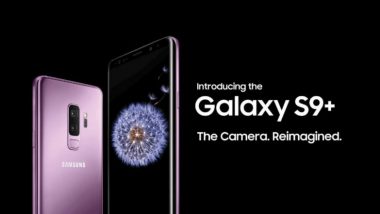Barcelona, Feb 26: Tech-giant Samsung on Sunday launched Samsung Galaxy S9 at Mobile World Congress 2018 here. The handset, which will be available on all major carriers in the US as well as unlocked direct from Samsung, has been priced $719.99 and $839.99 for the unlocked models, while the carrier pricing ranges from $720 and $840 to $800 and $930.
In colours such as black, purple, blue and grey, the handset will likely have other colour options later in the year. The South Korean company last year walked in with the Galaxy S8, which was one of the best phones of 2017 and one of the best products Samsung ever made. The Galaxy S9 and S9 Plus, which will be available for pre-order on March 2 and arrive in stores on March 16, are similar to the S8 and look and feel exactly the same.
The S9 pair has got S8's attractive and efficient design and extra tall 18.5:9 screens, curved sides, and glass front and backs. The 5.8-inch (S9) and 6.2-inch (S9 Plus) screens are the same Super AMOLED panels with 2960 x 1440 pixel resolutions, though the company says they are slightly brighter this year. The pair though has slightly different dimensions and weigh a little more.
The company also moved the fingerprint scanner from the right of the camera to below it, which makes it easier to use, especially on the larger S9 Plus.
The phones' hardware features such as the 3.5mm headphone jack remain the same as S8. The new pair flaunts speakers which now produce stereo sound and are 40 percent louder, according to Samsung.
The S9 runs Qualcomm's Snapdragon 845 processor (in North America, other markets can expect to see Samsung's latest Exynos processor); has either 4GB (S9) or 6GB (S9 Plus) of RAM; comes with 64GB of storage and support for microSD cards; has a 3,000mAh (S9) or 3,500mAh (S9 Plus) battery; is IP68 dust and water resistant; and supports both fast wired and fast wireless charging.
The phones can support speeds up to 1.2Gbps and support 600MHz frequencies for T-Mobile. The highlight new feature is the S9's new camera system, which comes as a single lens on the S9 and a dual camera on the S9 Plus. The new camera is Samsung's first with a mechanically adjustable aperture, which can switch between a very bright f/1.5 and a smaller f/2.4 depending on exposure conditions.
The bright aperture lets in 28 percent more light than the S8's f/1.7 lens and the f/2.4 aperture helps prevent overexposure in bright scenes such as a sunny outdoor day. The S9's 12-megapixel camera sensor includes second-generation dual-pixel autofocus tech for faster and more reliable focusing, improved multi-frame noise reduction for a claimed 30 percent better low-light performance, and the ability to record slow-motion video at up to 960 frames per second (at 720p resolution).
The camera app has been redesigned with quicker access to its various modes, much like how the iPhone's camera app works. The S9 Plus' second rear camera does not have the variable aperture feature but works similarly to the Note 8's dual camera system.
It has a f/2.4 lens that gets you two times closer to your subject than the wide-angle camera and allows for portrait-mode blurring effects (which Samsung calls "Live Focus"). Both phones have the same 8-megapixel f/1.7 autofocus front camera as last year's models. Integrated into the new camera app is Samsung's take on the iPhone X's Animoji, which it calls AR Emoji.
It captures an image of your face and builds a custom 3D character with your features. The app then creates 18 animated GIF "stickers" accessible for use in messaging apps. The company will launch Android 8.0 Oreo software for S9, but much like the hardware, the design is not hugely different from the software in the S8.
The phone also has redesigned parts of the Bixby app, most notably the camera features, which can be used to estimate calories in food and provide a faster real-time translation. Samsung has signed up new partnerships with retailers such as Sam's Club and Nordstrom to let you purchase items directly through Bixby and makeup from Sephora and Cover Girl. The Galaxy S9 and S9 Plus work with the same Gear VR that launched alongside the Note 8 and Google's Daydream View headset.
They also work with last year's DeX Station, which lets you use the phone as a full computer with a monitor, keyboard, and mouse. Samsung is also releasing a new DeX device called the DeX Pad. The Pad does not prop the phone up like the station but instead allows it to lie flat, where it can be used as a trackpad or keyboard.













 Quickly
Quickly


